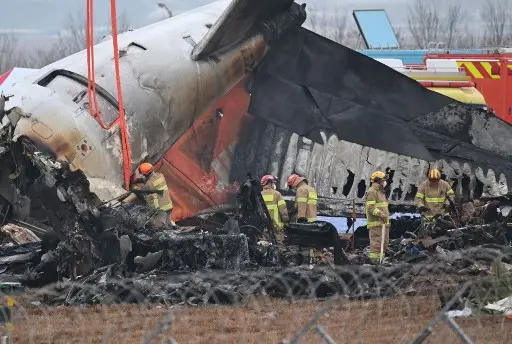In the shadow of South Korea’s most catastrophic aviation accident, the nation has been plunged into mourning and has launched sweeping measures to improve flight safety. The crash of Jeju Air Flight 2216, which resulted in the deaths of 179 individuals, has sent shockwaves through the country and the global aviation community.
The flight, traveling from Thailand to South Korea, ended in tragedy when the aircraft made a desperate emergency landing, crashing into a barrier and erupting in flames. Only two crew members survived, pulled from the wreckage amidst the devastation. The tragedy has prompted South Korean authorities to enact a nationwide review of all Boeing 737-800 aircraft in operation.
A Nation in Mourning
South Korea has entered a period of collective grief, marked by flag-lowering ceremonies and somber gatherings across the country. Acting President Choi Sang-mok, in his first public crisis since assuming office, visited the crash site to pay respects and pledged government support to the families of those lost. The president’s message underscored a commitment to a thorough investigation and renewed safety measures to restore public confidence in air travel.
At airports and in memorials set up nationwide, families of the victims have gathered, clinging to one another and searching for closure. The passengers on board ranged in age from toddlers to the elderly, with the majority being South Korean citizens. The tragedy has left an indelible mark on the collective conscience of the nation.
Comprehensive Safety Review Underway
As investigators work to piece together the final moments of Flight 2216, the South Korean Ministry of Transport has ordered a full inspection of all Boeing 737-800 aircraft operating under local carriers. Maintenance records, particularly concerning engines and landing gear, are being scrutinized. The effort, scheduled to extend into early 2025, reflects the urgency of ensuring the safety of the skies.
Both black boxes from the crashed aircraft have been recovered, providing critical data for aviation experts and international investigators, including representatives from Boeing and US aviation authorities.
Corporate Response and Broader Implications
Jeju Air, the operator of Flight 2216, has faced intense scrutiny in the aftermath of the disaster. In a public statement, the airline expressed profound regret and promised full cooperation with the ongoing investigation. However, the crisis deepened when another Jeju Air flight using the same aircraft model reported technical issues shortly after takeoff, raising questions about broader systemic risks.
The tragedy has also reignited conversations around the global oversight of aircraft manufacturing and operational safety standards. Boeing, already under scrutiny in recent years, faces renewed criticism as questions mount about the reliability of its 737-800 model.
Healing and Moving Forward
For many, the road to healing will be long. Families of the victims continue to wait for updates on identification efforts, while communities across the country hold vigils to honor the lives lost. Soldiers and emergency personnel remain at the crash site, meticulously sifting through debris in search of remains and personal effects.
As South Korea mourns, it also looks ahead with resolve, determined to prevent such a tragedy from ever happening again. The government’s swift response to review and reinforce aviation safety reflects the nation’s resilience and commitment to honoring the lives lost in this tragic event.






